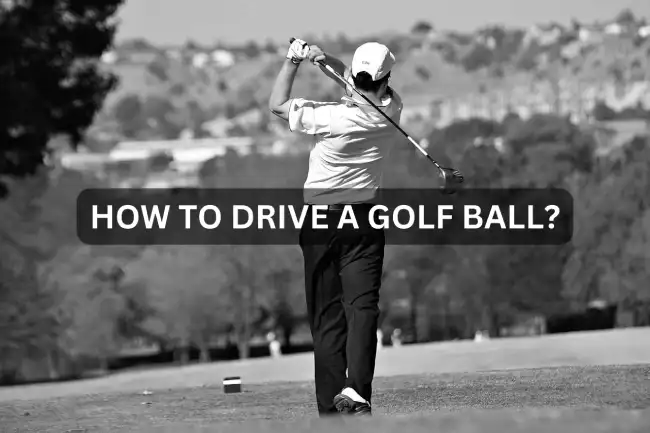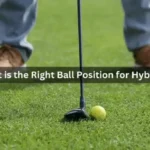Driving a golf ball effectively involves a combination of body mechanics, club selection, and mental focus. In this article, we will discuss the essential tips and techniques to help you drive the ball like a pro and elevate your golf game. Let’s tee off and explore the secrets to a powerful and accurate golf drive.
Understanding the Basics of Driving a Golf Ball

Before you step up to the tee box, it’s essential to understand the basics of driving a golf ball. Position yourself with your feet shoulder-width apart, the ball aligned with your front heel, and your body parallel to the target line. Grip the club with a light but firm grip, ensuring that the clubface is square to the target.
Addressing the Ball
As you address the ball, focus on maintaining a slight tilt away from the target, allowing for a sweeping motion through impact. Position the ball forward in your stance, ensuring that your hands are positioned just ahead of the ball. This setup helps promote an upward strike on the ball, optimizing distance and trajectory.
Backswing
Initiate the backswing by rotating your torso away from the target while maintaining a slight wrist hinge. Avoid excessive tension in your arms and shoulders, allowing for a smooth and controlled rotation. Achieve a full shoulder turn while keeping your lower body stable to generate power and coil energy for the downswing.
Downswing and Impact
As you transition into the downswing, start by shifting your weight towards the target while maintaining a lag in the clubshaft. This lag creates a whipping effect, increasing clubhead speed and maximizing impact efficiency. Focus on striking the ball with a slightly upward angle of attack, promoting a high launch and low spin for optimal distance.
Follow Through
A proper follow-through is crucial for driving accuracy and distance. After impact, continue rotating your body towards the target, extending your arms fully and releasing the club through the ball. Maintain balance and poise throughout the follow-through, allowing for a complete extension and a smooth finish to the swing.
Practice and Patience
Improving your driving skills takes time and dedication. Regular practice sessions focusing on technique, consistency, and timing will help you refine your driving abilities. Work with a professional instructor to identify areas for improvement and develop a personalized practice routine to enhance your driving performance.
Common Mistakes to Avoid When Driving a Golf Ball
Driving a golf ball is one of the most crucial aspects of the game. It can significantly impact your overall performance on the course. However, many golfers, especially beginners, tend to make common mistakes that hinder their ability to drive the ball effectively. By understanding and avoiding these mistakes, you can improve your golfing skills and enhance your performance on the course.
Not Using the Right Equipment
Using the proper equipment is essential when it comes to driving a golf ball. Many golfers make the mistake of using the wrong club or ball for their swing style and skill level. It is crucial to use a driver that suits your swing speed and provides you with the desired distance and accuracy. Additionally, using the right type of golf ball can also make a significant difference in your driving performance.
Poor Setup and Alignment
Another common mistake golfers make is having a poor setup and alignment before driving the ball. Proper alignment is crucial to ensure that you are hitting the ball in the right direction. Many golfers tend to misalign themselves, leading to inaccurate shots and loss of distance. It is essential to position your body, feet, and club face correctly to ensure a proper setup for an effective drive.
Incorrect Grip and Stance
Having the correct grip and stance is fundamental to driving a golf ball effectively. Many golfers overlook the importance of the grip and stance, which can significantly impact their driving performance. A proper grip ensures that you have control over the club throughout your swing, while a correct stance provides stability and balance during the shot. It is essential to maintain a neutral grip and shoulder-width stance to optimize your driving consistency.
Lack of Power and Speed
Generating power and speed are essential components of a successful golf drive. Many golfers make the mistake of focusing solely on hitting the ball with their arms, resulting in a lack of power and distance. To drive the ball effectively, you need to engage your entire body in the swing, utilizing your legs, hips, and core muscles to generate power. By incorporating a full body rotation into your swing, you can increase your clubhead speed and drive the ball farther down the fairway.
Ignoring Practice and Technique
Practice makes perfect when it comes to driving a golf ball. Many golfers neglect dedicated practice sessions focused on improving their driving technique. Without consistent practice and refinement of your driving skills, you are likely to make the same mistakes repeatedly. It is essential to work on your swing mechanics, timing, and tempo through regular practice sessions to enhance your driving performance on the course.
Choosing the Right Driver for Your Golf Game
The Importance of Choosing the Right Driver
When it comes to golf, one of the most crucial decisions that can significantly impact your game is choosing the right driver. A driver is a type of golf club specifically designed for hitting long-distance shots off the tee. Selecting the appropriate driver that suits your swing and style of play can lead to more accurate and powerful shots, ultimately enhancing your overall performance on the course.
Factors to Consider When Selecting a Driver
Clubhead Size and Material
The size of the clubhead plays a vital role in determining the forgiveness and power of the driver. Larger clubheads offer a larger sweet spot, making it easier to achieve greater distance and accuracy even on off-center hits. Additionally, the material of the clubhead can also impact your performance. Titanium clubheads are lightweight and durable, allowing for faster swing speeds and increased distance.
Shaft Flexibility and Length
The flexibility and length of the shaft are crucial considerations when choosing a driver. Shaft flexibility impacts the feel and control of your shots. Players with slower swing speeds often benefit from a more flexible shaft, while those with faster swing speeds may prefer a stiffer shaft for better accuracy. The length of the shaft also influences the distance and control of your shots, with longer shafts typically providing more distance but requiring better control.
Loft Angle
The loft angle of the driver refers to the angle of the clubface that controls the trajectory of the ball. Drivers with higher loft angles generate more backspin and a higher ball flight, making them ideal for players with slower swing speeds or those looking to maximize carry distance. On the other hand, drivers with lower loft angles produce less spin and a lower ball flight, suitable for players with faster swing speeds who prioritize roll distance.
Testing and Custom Fitting
Before making a final decision, it is essential to test out different drivers to determine which one feels the most comfortable and suits your playing style. Many golf stores and pro shops offer custom fitting services where experts analyze your swing characteristics to recommend the most suitable driver specifications for your game. Custom fitting can help optimize your launch angle, spin rate, and overall performance with the chosen driver.
How to Stay Calm and Focused
Driving a golf ball is not just a physical skill; it also involves a significant mental aspect that can greatly impact your performance on the course. Staying calm and focused while teeing off is crucial for achieving a successful drive. Here, we will explore some strategies to help you maintain mental composure and concentration when driving a golf ball.
The Importance of Mental Focus in Golf
In golf, the mental game is just as important as the physical game. Your ability to stay calm, focused, and confident can have a direct impact on your performance. When it comes to driving the ball off the tee, maintaining mental clarity is essential for achieving the distance and accuracy you desire.
Visualizing Success
One effective strategy to stay calm and focused while driving a golf ball is visualization. Before stepping up to the tee, take a few moments to visualize the perfect drive. Imagine the ball flying straight down the fairway, exactly where you want it to land. This mental imagery can help build confidence and reduce anxiety, setting the stage for a successful drive.
Deep Breathing and Relaxation Techniques
Deep breathing exercises and relaxation techniques can help calm your nerves and focus your mind before teeing off. Take a few deep breaths, focusing on each inhale and exhale, to center yourself and release any tension or anxiety. By incorporating relaxation techniques into your pre-shot routine, you can cultivate a sense of calm and clarity that will benefit your drive.
Positive Self-Talk
The way you speak to yourself can significantly impact your mindset on the golf course. Instead of focusing on potential mistakes or negative outcomes, practice positive self-talk to boost your confidence and concentration. Remind yourself of your skills and abilities, reinforcing a mindset of strength and capability as you prepare to drive the ball.
Maintaining a Routine
Establishing a pre-shot routine can help you stay focused and composed when driving a golf ball. By following the same series of steps before each drive, you create a sense of familiarity and consistency that can enhance your mental stability. Whether it’s aligning your stance, taking practice swings, or visualizing your shot, a routine can help you stay in the moment and ready to execute a successful drive.
FAQS
Q: What is the ideal ball position for driving?
A: The ball should be positioned just inside the lead foot. This setup helps to hit the ball on the upswing, which can maximize distance by reducing spin.
Q: How can I improve my downswing when driving a golf ball?
A: Focus on starting your downswing with your lower body, ensuring your hips lead before your upper body and arms. Keep your head still to maintain balance and ensure accurate hits. It’s crucial to develop a smooth transition without rushing, to maximize power and control
Q: What are some common mistakes to avoid in my golf drive?
A: Common mistakes include keeping the ball too far back in your stance, which can increase spin and reduce distance. A narrow stance or incorrect clubface alignment can also affect your drive’s effectiveness. It’s important to ensure a wider stance and align the clubface correctly to avoid slices or hooks
Q: Can using a launch monitor help improve my golf drive?
A: Utilizing a launch monitor can provide valuable insights into your swing dynamics, such as clubhead speed, spin rates, and launch angles. This feedback can help you make adjustments to improve both the distance and accuracy of your drives
Q: What tips can help me hit the ball farther?
A: To increase drive distance, focus on choosing the right club with the proper loft, positioning the ball correctly in your stance, and maintaining a steady posture. Ensuring you have the right grip and swing tempo are also critical factors. Additionally, training aids and professional lessons can provide personalized tips and corrections







